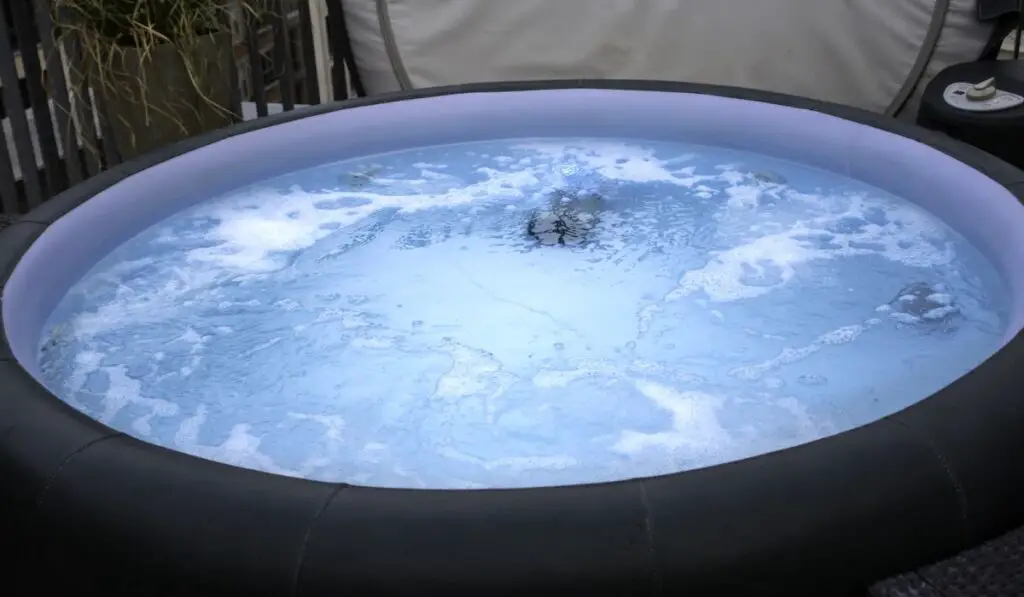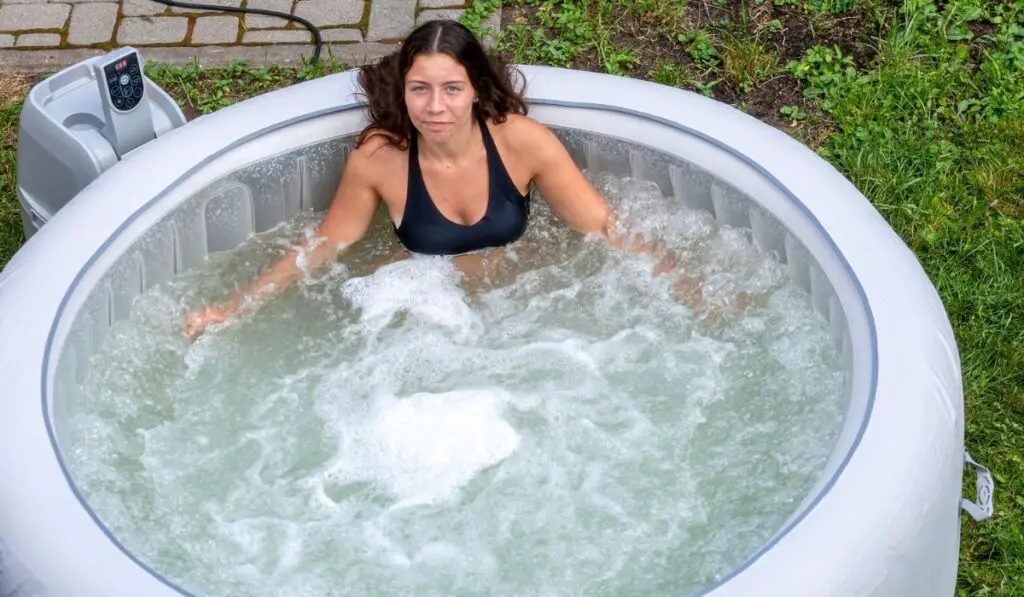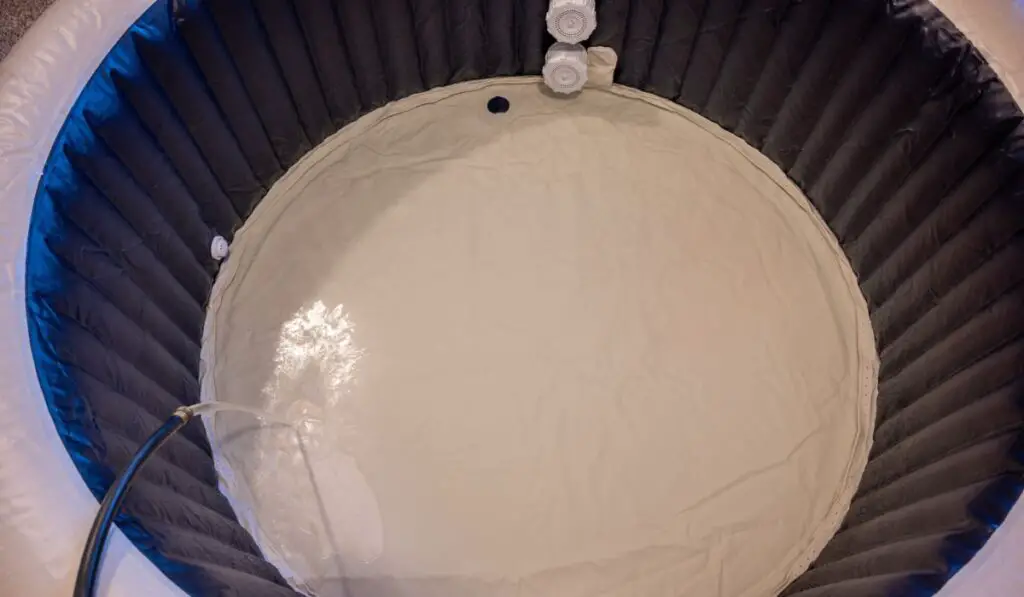Inflatable hot tubs have become quite popular in recent years. They’re portable, easy to carry, and relatively affordable. However, you should also consider the lifetime of these tubs before buying one, since inflatable hot tubs don’t last as long as traditional ones.
The average lifespan of an inflatable hot tub is 2-3 years. The tub’s quality, frequency of use, and weather conditions can affect its lifespan. If you deflate and store the tub when it’s not in use and keep it away from pets and out of direct sunlight, it’ll likely last longer.
Let’s take a closer look at how long the average inflatable hot tub lasts and how to keep your tub in good working condition for as long as possible.
How Does an Inflatable Hot Tub Work?

Inflatable hot tubs are similar to inflatable pools; they need to be filled with air for starters. You can then wash the tub and fill it with fresh water.
Inflatable hot tubs have power jets that produce water bubbles and help keep the water running inside the tub. Inflatable hot tubs also have heaters, which you’ll need to attach if you want to use them in the winter.
Many hot tubs also come with a testing kit, which is useful for balancing the water’s pH level.
Inflatable hot tubs are portable, cheaper than regular hot tubs, and much easier to use. The hot tubs are also safe for kids since there’s less risk of water overheating.
Many tubs — like this Bestway tub (on Amazon) — also come with a cover, which you can purchase separately if yours doesn’t have one.
While inflatable hot tubs are certainly the best option if you’re looking for something portable and easy to set up, their lightweight design comes with some downsides as well.
Downsides of an Inflatable Hot Tub

- Lower quality: Inflatable hot tubs have much lower quality than permanent ones since they are built from plastic that can get punctured. You’ll have to keep your tub away from sharp objects and pests.
- Lower lifespan: Inflatable hot tubs have an average lifetime of 2-3 years, while non-inflated tubs can easily last up to 15 years.
- Difficult to use in the winter: Severe winter can cause mild damage to your tub, especially if you use it outdoors. When the temperature drops below 40 degrees Fahrenheit, the tub’s wall, jet, and filters may freeze.
- Less insulation: Most inflatable hot tubs come uninsulated, and they’re unable to retain the temperature inside the tub. This results in more energy usage to warm the tub.
- Higher operating cost: If you really want to fully enjoy a spa in your tub, you’ll need to keep the jets on to make water bubbles for you. You’ll also need to switch the heater on if you’re using it in the winter, which increases the operating costs.
But, despite these downsides, inflatable hot tubs are still a great option in the short term since they’re much cheaper and easier to use than traditional tubs.
How Long Will an Inflatable Hot Tub Last?
While the average lifespan of an inflatable hot tub is 2-3 years, many tub owners claim that a tub can be used for up to 5 years. Still, others claim that it doesn’t even last a few months.
The lifespan of your inflatable hot tub will often depend on its quality and how well you maintain it.
While many hot tub companies like Intex give a warranty for a few years, most warranties don’t include punctures and small repairs, and you’ll need to do these on your own. Eventually, you may regret purchasing a low-quality inflatable hot tub, even if it’s easy to repair.
When you get a good quality tub that lasts for longer, you’ll pay less for repairs and maintenance in the long run. Many of the top hot tub companies offer double puncture protection, which can withstand sharp objects without getting damaged.
Since inflatable hot tubs are already relatively cheap, it’s best to avoid buying a low-quality one. You’ll end up spending more on repairing punctures, maintenance, damaged jets and filters, and other fixes.
Factors That Affect a Hot Tub’s Lifespan
How long your inflatable hot tub will last depends upon many factors, such as its price and frequency of use. Weather conditions in your area and the tub’s material also impact its lifespan.
If you’re buying an inflatable hot tub, you’ll want it to last as long as possible. Fortunately, you can outlast the warranty period by taking special care of your tub, choosing one that has good quality, and keeping the water balanced.
Factors that affect an inflatable hot tub’s lifespan include:
The Price of the Tub
One of the most important factors that affect the lifespan of your tub is its price. In most cases, the tub’s price is indicative of its quality.
While you may save some money in the short term by buying a cheaper hot tub, you’ll likely end up spending more on repairs later on.
Cheaper hot tubs also don’t have the same type of protection against punctures, and they’re usually designed to last no more than a couple of years. Higher-priced tubs are often made from better quality material and have safety features that protect the tub’s equipment in cold weather.
So, if you’re looking for a new inflatable hot tub that will last several years, don’t hesitate to spend some extra cash to get a better-quality option. This tub from Intex (on Amazon) is one of our favorites.
Frequency of Use
Your tub’s lifespan also depends on how frequently you use the tub. Most people use a hot tub for special events or with their friends or family, and few use it regularly.
Inflatable hot tubs are designed to be used occasionally since it makes more sense to build a permanent spa in your home if you’re going to use it all the time.
However, you can also use your hot tub regularly if you maintain it properly. If you aren’t taking care, overusing the tub can damage it and reduce its lifespan.
If you do use the inflatable hot tub frequently, make sure that you regularly check the water balance, pump, and heater, so you don’t run into expensive problems.
Weather Conditions
The weather conditions in which you use the tub can also affect its lifespan. If you’re using the tub in very hot weather, it will weaken the tub’s vinyl walls, and they will eventually get damaged.
If you use the tub regularly in freezing temperatures, it may damage the filters and freeze the jets.
The best time to use an inflatable hot tub is when the temperature is between 80 and 100 degrees Fahrenheit. You can use a hot tub in colder weather, but preferably do it when there’s no snow or frost.
This doesn’t mean you can’t use your hot tub in the off-season. Hot tubs can withstand lower temperatures, around 40 degrees Fahrenheit, and won’t get damaged immediately when the temperature drops to below freezing.
However, extreme heat and cold will damage your hot tub much faster.
The Water’s Chemical Balance
The water’s cleanliness and chemical balance will also affect your hot tub’s lifespan. If you leave the water stagnant for too long and don’t sanitize it, it will become infested with bacteria, algae, and other microorganisms.
The dirt on the tub will also be harder to remove without regular cleaning, which is why it’s essential that you drain and clean the hot tub regularly.
You’ll also need to use chemicals such as bleach or chlorine to make your tub’s water hygienic. However, be careful to follow the right instructions when adding them, as an imbalance of these chemicals can also damage the tub.
Care Tips to Make Your Inflatable Tub Last

There’s no need to worry about how long your hot tub will last if you take good care of it. Simple steps such as deflating and storing it in the winter, keeping it away from pets, and not placing it in direct sunlight can significantly increase your tub’s lifespan.
Here are some tips to help preserve your inflatable hot tub:
Deflate and Store It in the Winter
You can increase the longevity of your inflatable hot tub if you’ll deflate it correctly and store it in the winter. Enjoying the hot tub all year round is great, but it’s not worth risking its lifespan and costing you money.
Here’s how to deflate your tub correctly:
- Look for nozzles and open them. The nozzle placement is different based on the model you’re using. If you have a simple model, you’ll find the nozzles at the bottom of either of the tub’s corners. If you have a more complex model, you may need to read the manufacturer’s guide to locate the nozzles.
- Drain the tub’s water completely. Use a scrubber to suck the water left in the bottom. Use a cloth to dry the remaining water from the tub’s surface.
- Disassemble all the parts, including the water jets, filters, and heater. Be careful, as damaging these can be expensive.
- Carefully wrap up the tub and store it in a dry place away from sharp objects. If you have the container in which you got the tub, store it there for better protection.
Keep It Away From Pets
If you want to increase the lifespan of your tub and avoid unnecessary repairs, you’ll keep it away from pets. Pets have teeth and sharp nails, and they may unwillingly puncture the tub. While you can repair a hot tub puncture, it’s still a hassle and will end up reducing the tub’s lifespan.
If you still want to enjoy the tub with your pets, you’ll need to be more careful. Make sure to wash them before putting them inside the tub, as it can prevent bacteria from infesting the tub’s water.
Place It Out of Direct Sunlight
When you place your tub away from direct sunlight, it’ll prevent any damage to the tub caused by UV rays.
Most hot tubs are made from material that isn’t UV-resistant, and constant exposure to sunlight will weaken the hot tub’s outer structure.
If you’re willing to spend a few extra dollars on a quality hot tub, you can get one made from UV-resistant material.
